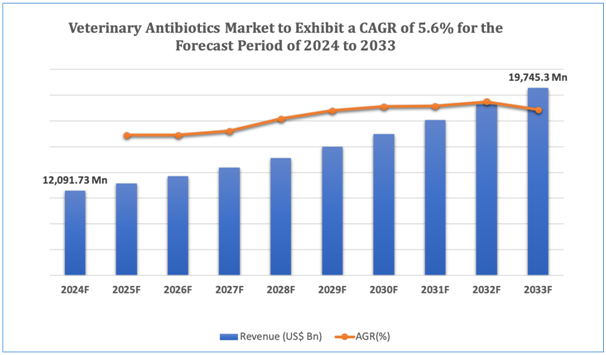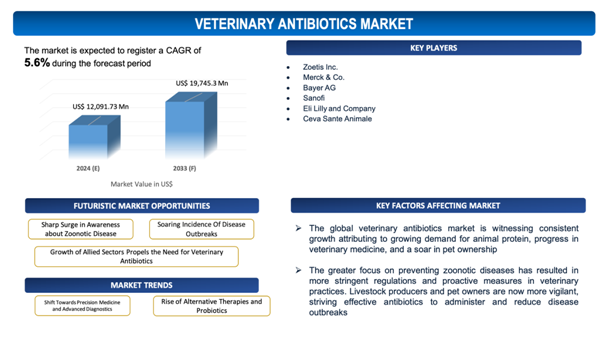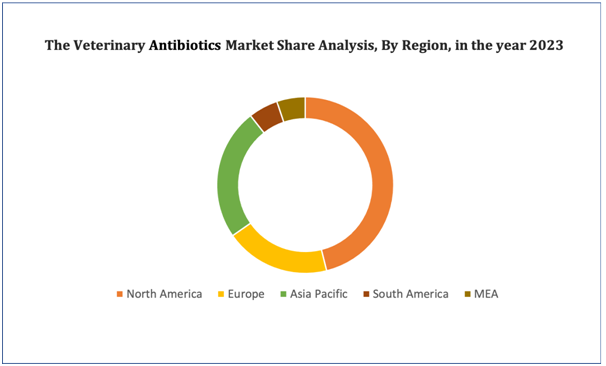Veterinary Antibiotics Market Overview
The global veterinary antibioticsmarket is estimated to be worth over USD 19,745.3Mn in 2033 and is expected to grow at CAGR of 5.6% during the forecast period (2024-2033).
Veterinary antibiotics are transforming the veterinary health landscape by notablyenhancing the prevention, regulate, and treatment of bacterial infections in animals. These medications are necessary for maintaining the health and productivity of poultry, livestock, and companion animals, directly influencing the agriculture sphere and public health. The global veterinary antibiotics marketis witnessingconsistent growth attributing to growing demand for animal protein, progress in veterinary medicine, and a soar in pet ownership. Antibiotics such as penicillins, tetracyclines, macrolides, and sulfonamides are extensively used not only for therapeutic purposes but also as preventive measures to protect animal health, thusmitigating mortality rates and improving overall productivity.
The use of veterinary antibiotics is specificallyrevolutionary in regions with bolstering livestock industries, such as Asia-Pacific, where enhancing veterinary healthcare infrastructure is critical for facilitating the soaring demand for meat and dairy products. Regardless, the indiscriminate usage of antibiotics has raised major concerns about antimicrobial resistance (AMR), which jeopardizes both animal and human health by interpreting infections harder to treat.
In its response, the veterinary field is experiencing a transition towards more judicious use of antibiotics, fuelled by regulatory pressures and an escalated focus on AMR mitigation. This comprises the development and adoption of alternative therapies such as vaccines, probiotics, and phage therapy, which offer promising avenues to reduce dependency on antibiotics. In addition, technological breakthroughs in precision medicine and diagnostics are holding a crucial role in revolutionizing veterinary healthcare.
These innovations allow more precise diagnoses and targeted treatments, optimizing antibiotic use and minimizing the risk of resistance.The continuous evolution in veterinary antibiotics, underpinned by regulatory frameworks and technological advancements, is critical for ensuring sustainable animal health management. By balancing effective antibiotic use with alternative measures, the veterinary health landscape is poised for significant transformation, improving animal welfare and public health outcomes worldwide.
Figure 1. Veterinary Antibiotics: Market Size

Get more details on this report - Request Free Sample
Key Market Insights &Current Market Landscape
The global veterinary antibiotics market is booming, fuelled by the growing need to ensure animal health and productivity amidst increasing demands for animal protein and pet care. Major market developments are emphasized on addressing the urgent issue of antimicrobial resistance (AMR). Regulatory bodies are stiffening controls on antibiotic use, pushing for more judicious application and fostering the development of alternative treatments. This has resulted ingreater investment in vaccines, probiotics, and phage therapy as viable alternatives to conventional antibiotics.
Novel technologies are also redefining the market panorama. Precision medicine and advanced diagnostics are becoming integral, enabling targeted treatments that minimize the risk of resistance and improve animal health outcomes. Innovations such as genomic sequencing and biomarker identification are enabling for more accurate identification of infections and tailored therapeutic approaches.
Market Dynamics
Market Drivers
Sharp Surge inAwareness about Zoonotic Disease &Soaring Incidence Of Disease Outbreaks
Zoonotic diseases, which are transferred from animals to humans, presentsevere public health risks, portrayed by recent outbreaks like swine flu, avian influenza, and the COVID-19 pandemic. This escalated awareness has highlighted the crucial need for robust animal health management practices to prevent and regulate such diseases at their source. As a result, there is a soaring demand for veterinary antibiotics to treat bacterial infections in animals, ensuring their health and avoiding the spread of infections to humans.
The greater focus on preventing zoonotic diseases has resulted in more stringent regulations and proactive measures in veterinary practices. Livestock producers and pet owners are now more vigilant, striving effective antibiotics to administer and reduce disease outbreaks. This soar in demand is fuelled by the need to maintain animal health, ensure food safety, and safeguard public health.
Along with that, the increasing incidence of disease outbreaks has encouragedsubstantial investments in veterinary healthcare infrastructure and research. International health organizations, governments, and private sectors are cooperating to develop and deploy effective antibiotics and alternative therapies. This collaborative effort focusedonimproving disease surveillance, enhance diagnostic capabilities, and ensure timely intervention, further accelerating the veterinary antibiotics market.
Market Restraints
With regard to numerous advantages of Veterinary Antibiotics, the market faces several challenges due to the unique characteristics and requirements associated with these potent pharmaceutical products. Some of the key market challenges include:
- Antimicrobial Resistance (AMR) Concerns: The prevailing and often indiscriminate use of veterinary antibiotics has led to a substantial increase in antimicrobial resistance. This resistance diminishes the efficiency of antibiotics, making infections difficult to treat in both animals and humans. Regulatory bodies across the world are implementing stringent controls and guidelines to restrain antibiotic use, which could impede market growth. The push for mitigated antibiotic usage and the transition towards alternative treatments like vaccines and probiotics present a significant restraint on the market.
- Stringent Regulatory Environment: The veterinary antibiotics market is heavily controlled to ensure the efficacy and safety of these drugs for both animals and humans. Regulatory agencies such as the FDA, EMA, and other national bodies have stricter approval processes and post-market surveillance requirements. Compliance with these regulations can be time-consumingand costly, presenting a hindrance to market entry for new players and potentially pacing down the introduction of new antibiotics. Alongside, persistent changes in regulations, focused at combating AMR, can result in market uncertainty and greater operational costs for existing companies.

Get more details on this report - Request Free Sample
Market Opportunity
Growth of Allied Sectors Propels the Need for Veterinary Antibiotics
The growth of allied sectors, such as animal antimicrobials and antibiotics, is projected to substantiallypropel the necessity for veterinary antibiotics attributing to the consolidated approach required for comprehensive animal health management. As these sectors advance, they bring innovations and improved formulations that enhance the safety and efficacy of antibiotic treatments. This synergy improves the overall health and productivity of livestock and pets, nurturing a more strong demand for veterinary antibiotics.
The development of novel antimicrobial products, comprising combination therapies and novel antibiotics, directly facilitates the veterinary antibiotics market by providing more effective solutions for treating an extensive range of bacterial infections. These breakthroughs not only address existing health issues more effectively but also aid in administering emerging diseases, thus expanding the scope and need of veterinary antibiotics.
Along with that, the incorporation of advanced diagnostics and precision medicine from allied sectors allows more precise disease detection and targeted treatments. This accuracyminimized the misuse of antibiotics, ensuring that they are used effectivelyand appropriately, thusfuelling their persistent need and relevance in veterinary practice.This continuous innovation cycle ensures that the veterinary antibiotics market remains dynamic and capable of fulfilling the evolving challenges posed by bacterial infections and resistance issues.
Market Trends
- Shift Towards Precision Medicine and Advanced Diagnostics: One of the major trends in the global veterinary antibiotics market is the soaring adoption of precision medicine and advanced diagnostic tools. Precision medicine enables for more targeted and individualized treatments, reducing the unnecessary use of antibiotics and assisting to battle antimicrobial resistance (AMR). Advanced diagnostic tools, comprising genomic sequencing and biomarker identification, allow veterinarians to quickly and preciselydetermine infections and tailor antibiotic treatments to specific pathogens. This trend is boosting the development of more sophisticated antibiotic therapies and enhancing overall treatment outcomes, thusimproving the demand for specialized veterinary antibiotics.
- Rise of Alternative Therapies and Probiotics: In terms of the increasing concerns over AMR and the regulatory push for minimized antibiotic usage, there is a remarkable trend towards the adoption of alternative therapies and probiotics in veterinary medicine. Vaccines, immunomodulators, and phage therapy are gaining momentum as effective preventive measures against bacterial infections. Probiotics and prebiotics are increasingly used to improve gut health and immunity in animals, thusminimizing the dependency on antibiotics for disease prevention and treatment. This trend is reshaping the market outlook, with several pharmaceutical companies expanding their portfolios to comprise these substitutes alongside conventional antibiotics, thereforefuelling innovation and diversification in the market.
Veterinary Antibiotics Market: Key Segments
By Product Type
- Tetracyclines
- Penicillins
- Macrolides
- Sulphonamides
- Aminoglycosides
- Others
By Route of Administration
- Premixes
- Injections
- Oral Powders
- Oral Solutions
- Others
By Animal Type
- Food-processing Animals
- Companion Animals
By Key Geographical Regions
- North America
- Europe
- Asia-Pacific
- Middle East and Africa
- South America
Veterinary Antibiotics Market: Segmental Analysis
On the basis of product type, the global veterinary antibioticsmarket is segmented into Tetracyclines, Penicillins, Macrolides, Sulphonamides, Aminoglycosides, Others. Tetracyclines hold the dominant share in the global veterinary antibiotics market due to their broad-spectrum efficacy against a wide range of bacterial infections in various animals. They are highly effective in treating respiratory, urinary, and intestinal infections, making them versatile and widely applicable. Additionally, their relatively low cost, ease of administration, and long-standing use in veterinary medicine contribute to their predominant position in the market.
On the basis of route of administration, the market is segmented into Premixes, Injections, Oral Powders, Oral Solutions, Others. Premixes hold the dominant share in the global veterinary antibiotics market attributing to their convenience and effectiveness in large-scale livestock farming. They enable for easy and uniform mixing with animal feed, ensuring continuous and widespread antibiotic delivery to entire herds or flocks. This method reduces labour costs and ensures improved compliance, making it a preferred choice for administering animal health in intensive farming operations.
Figure 4. Veterinary Antibiotics Market: Distribution by Region

Get more details on this report - Request Free Sample
Veterinary Antibiotics Market: Regional Analysis
Attributing to the increasing animal farming, soaring expenditures on animal healthcare, and growing demand for food products derived from animals, North America holds the dominant revenue share in the global veterinary antibiotics market. This isowing to the region's surging demand for animal food products. Moreover, Asia Pacific is projected to grow at a rapid pace over the forthcoming years owing to the APAC market for animal-derived food is growing as a result of factors such as an expanding animal population and an increased demand for animal-derived food products.
Veterinary Antibiotics Market: Recent Developments
- In February 2024, Blacksmith Medicines, Inc. (Blacksmith), a leading biopharma dedicated to discovering and developing medicines targeting metalloenzymes, and Zoetis, the world's leading animal health company, announced a collaboration to discover and develop novel antibiotics for animal health.
- In July 2022, Krka has extended its companion animal product range with the launch of Cladaxxa, a broad-spectrum antibiotic offering proven efficacy in the targeted treatment of respiratory, digestive, urinary, skin and dental infections in dogs and cats.
Leading Veterinary Antibiotics Developers
Industry Trends and Global Forecasts, 2023-2035 report features an extensive study of the current market landscape, market size and future opportunities associated with the Veterinary Antibiotics market, during the given forecast period. Further, the market report highlights the efforts of several stakeholders engaged in this rapidly emerging segment of the biopharmaceutical industry. Key takeaways of the Veterinary Antibiotics market are briefly discussed below.
The report includes the list of players operating in the global veterinary antibioticsmarket. Some of the key players include:
- Zoetis Inc.
- Merck & Co.
- Bayer AG
- Sanofi
- Eli Lilly and Company
- Ceva Sante Animale
Scope of the Report
The market report presents an in-depth analysis of the various firms / organizations that are engaged in this market, across different segments, as defined in the below table:
|
Key Report Attributes |
Details |
|
Base Year |
2023 |
|
Forecast Period |
2024-2033 |
|
CAGR (2024-2033) |
5.6% |
|
Product |
|
|
Route of Administration |
|
|
Animal Type |
|
|
Key Geographical Regions |
|
|
Key Companies Profiled |
|
